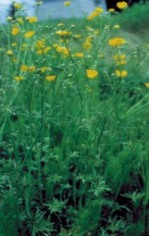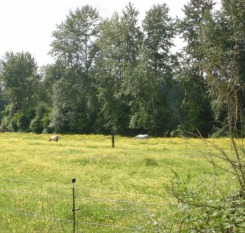Tall buttercup identification and control
Ranunculus acris

Tall buttercup is not on the Washington State Noxious Weed List. However, in King County, Washington this non-native invasive buttercup species is classified as a Weed of Concern. For more information on noxious weed regulations and definitions, see Noxious weed lists and laws.
Identification
Tall buttercup is an upright, perennial broadleaf plant that grows from a cluster of fibrous roots. Stems are 1 to 3 feet tall, hairy, hollow, leafy below and branched above. Each root crown typically has several stems in a cluster. Flowers have 5 to 7 glossy yellow petals, are about 1 inch wide, and grow on long stalks.
Leaves at the base grow on long stalks and are divided deeply into 3 to 7 coarsely lobed segments that radiate from a common point like fingers on a hand. The upper leaves are smaller and have fewer lobes and teeth. Leaves are softly hairy. Seedlings have 2 egg-shaped cotyledons with 3 to 5 noticeable veins. Young plants form a rosette. The first true leaves are hairy, round to heart-shaped in general outline, and shallowly lobed and toothed. Leaves have long leaf stalks that are hairy except at the base.
Impacts
Tall buttercup can dominate a pasture or meadow given the opportunity, especially with acid soils and/or over-grazing. It could hinder colonization by native species in a prairie or grassland habitat if it were allowed to invade and spread.
Growth and reproduction
Tall buttercup spreads only by seed and is a short-lived perennial. It blooms from late May to September and is pollinated by a variety of insects. Seeds are dispersed by wind, birds, farm animals, small rodents, clothes and tires. Seed germination is usually in spring and generally requires open soil.
Tall buttercup can be found in a variety of habitats, including wet lowlands and rich woodlands and is a common weed in pastures, meadows, and along roadsides. It usually does not persist in cultivated fields. Tall buttercup prefers heavy, moist soils but can grow in sandy or gravelly soil is there is sufficient moisture available.
Control
Prevention and cultural control
- In lawns and pastures, promote healthy grass by overseeding, fertilizing as needed, and not over-grazing. Adding lime can improve grass health and keep buttercup from re-establishing. However, lime won’t control buttercup that is already well-established.
- It also helps to improve soil drainage. Reduce compaction by aerating and avoid trampling when soils are wet.
- Clean mowers and other equipment to avoid spreading buttercup seeds to un-infested areas.
Manual
- Pull or dig up plants, removing all of the roots. Digging is most effective in the spring and early summer while the soil is moist and roots won’t break off as much.
- Disturbance of the soil can increase seed germination.
Mechanical
- This weed will not survive cultivation so plowing a field or meadow will help control it.
Chemical
- Herbicides can be used if allowed and appropriate for the site and land use. Follow all label directions to ensure safe and effective use.
- Broadleaf herbicides can be applied over grassy areas infested with creeping buttercup to selectively kill the buttercup and not the grass. Products containing the active ingredient MCPA are most effective on buttercup. Metsulfuron (Escort, Ally) is also effective but can harm some grasses. Follow label directions on timing and rates.
- Glyphosate (e.g. Roundup, Aquamaster) can be applied to actively growing plants before they seed. Keep spray off of grass and other plants. Re-seed or re-plant bare areas after removing buttercup to keep it from re-infesting the area.
- It will probably take at least two or three applications to eradicate tall buttercup because of the seed bank and because some mature plants will generally recover.
- Monitor the treated area for re-growth and pull up any new seedlings before they establish runners.
Additional information on tall buttercup (Ranunculus acris )
- Photos and Distribution from the University of Washington Burke Museum (external link)
- Alaska Natural Heritage Program (external link, pdf)
- Ohio Perennial and Biennial Weed Guide (external link)
- Photos of Tall Buttercup from Invasive.org (external link)
- Photos of Tall Buttercup from Forestry Images (external link)
What to do if you find this plant in King County, Washington
Because tall buttercup is so widespread, property owners in King County are not required to control it and we are not generally tracking infestations. We can provide advice on how to control tall buttercup, but there is generally no legal requirement to do so.
Related information
Related agencies
Program offices are located at 201 S. Jackson St., Suite 600, Seattle, WA 98104. To contact staff, see the Noxious Weed Control Program Directory, send an email, or call 206-477-WEED (206-477-9333).

 Translate
Translate
